Archive:Air transport services statistics - NACE Rev. 2
- Data from April 2013. Most recent data: Further Eurostat information, Main tables and Database.
This article presents an overview of statistics for air transport services in the European Union (EU), as covered by NACE Rev. 2 Division 51.
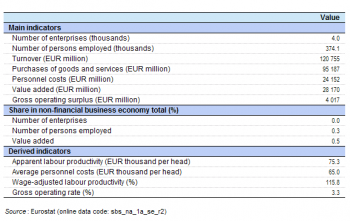
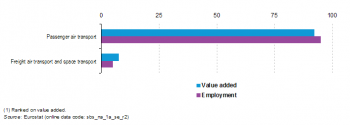
(% share of sectoral total) - Source: Eurostat (sbs_na_1a_se_r2)




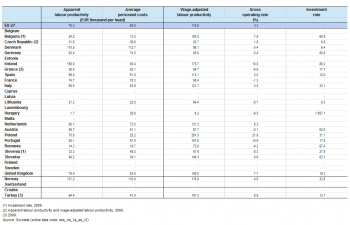

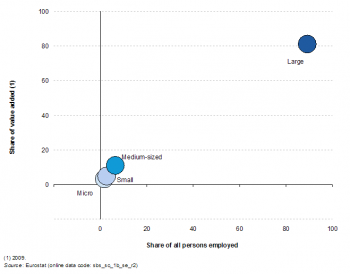
(% share of sectoral total) - Source: Eurostat (sbs_sc_1b_se_r2)

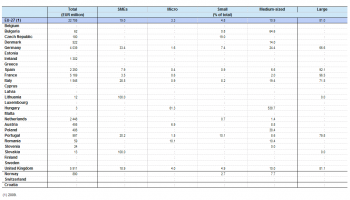
Main statistical findings
Structural profile
There were approximately 4 thousand enterprises operating within the air transport services sector (Division 51) in the EU-27 in 2009. Together they employed 374 thousand persons, equivalent to 0.3 % of the non-financial business economy (Sections B to J and L to N and Division 95) workforce or 3.7 % of the total number of persons employed in transportation and storage services (Section H). EU-27 air transport services generated EUR 28.2 billion of value added in 2010, which was 0.5 % of the non-financial business economy total and 6.0 % of the transportation and storage services total.
The apparent labour productivity of the EU-27’s air transport services sector in 2010 was EUR 75.3 thousand per person employed, which was considerably higher than either the non-financial business economy average (EUR 44.8 thousand per person employed) or the transportation and storage services average (EUR 47.2 thousand per person employed). Although apparent labour productivity was relatively high, the EU-27’s air transport services sector had even higher average personnel costs, which rose to EUR 65.0 thousand per employee in 2010. These high average personnel costs were more than twice the non-financial business economy average (EUR 30.9 thousand per employee) and ranked third highest across the NACE divisions that compose the non-financial business economy. The high level of average personnel costs impacted upon the wage-adjusted labour productivity ratio which combines the two previous indicators and shows the extent to which value added per person employed covers average personnel costs per employee. This ratio was 115.8 % for the EU-27’s air transport services sector in 2010 which was considerably lower than the non-financial business economy average of 144.8 %; indeed, it ranked among the 10 lowest wage-adjusted labour productivity ratios in 2010 recorded by any of the non-financial business economy NACE divisions.
The gross operating rate measures the relation between the gross operating surplus and turnover and is one measure of operating profitability; it stood at 3.3 % for the EU-27’s air transport services sector in 2010. This was the third lowest value recorded for this rate among any of the NACE divisions within the non-financial business economy.
Sectoral analysis
The air transport services sector is divided within NACE into passenger air transport (Group 51.1) on the one hand, and freight air transport and space transport (Group 51.2) on the other. By far the largest of these two subsectors — no matter which measure of size is used — was the passenger air transport subsector. It accounted for 92.3 % of sectoral value added in the EU-27’s air transport services sector in 2010 and 94.9 % of its workforce. There were about five times as many passenger air transport enterprises as there were freight and space transport enterprises.
The apparent labour productivity of the EU-27’s passenger air transport subsector was EUR 73.2 thousand per person employed in 2010, while that for freight air transport and space transport was considerably higher, at EUR 114.2 thousand per person employed. Average personnel costs were somewhat closer, but again the freight air transport and space transport subsector reported a higher level (EUR 76.6 thousand per employee) when compared with average personnel costs for passenger air transport (EUR 64.4 thousand per employee). The resulting wage-adjusted labour productivity ratio (which combines the results of the first two indicators) was 149.2 % for the freight air transport and space transport subsector, slightly above the non-financial business economy average (144.8 %), whereas the ratio for the passenger air transport subsector (113.6 %) was considerably lower. Indeed, it was the lowest wage-adjusted labour productivity ratio in 2010 among any of the transportation and storage services NACE groups.
The gross operating rate for the EU-27’s passenger air transport subsector was 3.0 %, which was the fifth lowest value across all of the NACE groups within the non-financial business economy in 2010 and the lowest among all transportation and storage services NACE groups. The gross operating rate for the freight air transport and space transport subsector was more than twice as high, at 6.4 %, but remained well below the non-financial business economy average (10.1 %).
Country analysis
Compared with many activities, the air transport services sector remains relatively concentrated within a few of the EU Member States, reflecting the distribution and economic performance of Europe’s main airlines and those airports that serve as hubs between inter-continental, international and domestic services. Nevertheless, since the early 1990s there has been a significant shift in the make-up of the air transport services sector within the EU, away from a model that was dominated by large, national carriers that often had a monopoly. With deregulation, market entry (principally from low-cost carriers), increased choice concerning the routes available to consumers and (at least in some cases) led to downward price pressure. Furthermore, the air transport services sector in the EU-27 witnessed an expansion in passenger numbers.
The United Kingdom had the highest share (21.0 %) of EU-27 value added for the passenger air transport subsector in 2010, while France also accounted for a relatively high share (18.3 %); Germany (14.3 %) was the only other Member State (for which data are available) to record a share that was into double-digits. For the freight air transport and space transport subsector, Germany recorded the highest share (38.5 %) of EU-27 value added in 2010, followed by the United Kingdom (16.6 %). Ireland’s 4.6 % share of EU-27 value added in the air transport sector was its third largest share in 2010 among the non-financial business economy NACE divisions.
While the air transport services sector was dominated by the larger EU Member States, there were relatively high degrees of specialisation in a limited number of other countries. For example, Ireland reported that the contribution of its air transport sector to non-financial business economy added value in 2010 was 1.6 %, which was 3.4 times as high as the EU-27 average. Portugal (1.3 % of non-financial business economy value added in air transport) was the next most specialised Member State, followed by the Netherlands, the United Kingdom and France.
Ireland’s specialisation in the air transport sector was a result of its high specialisation for passenger air transport. Within the freight air transport and space transport subsector, Bulgaria and Latvia were the most specialised countries, as this activity contributed more than twice as much added value to the national non-financial business economy total as the average across the whole of the EU-27.
As noted, the economic performance and profitability of the EU-27’s air transport services sector (as measured by the wage-adjusted labour productivity ratio and the gross operating rate) was relatively weak. Just nine of the 19 Member States for which data are available reported wage-adjusted labour productivity ratios above 100 % in 2010 (latest data is for 2009 for the Czech Republic and Greece). France and Germany were among those Member States where average personnel costs were not covered by apparent labour productivity, while in Hungary the air transport services sector recorded a wage-adjusted labour productivity ratio of just 4.2 %, reflecting apparent labour productivity of only EUR 1.7 thousand per person employed.
The highest gross operating rate for air transport services was registered in Poland, at 21.6 % in 2010, while Portugal (10.9 %) and Ireland (10.8 %) were the only other EU Member States to record double-digit rates. Indeed, there were only 10 Member States that reported positive gross operating rates in 2010, while nine had negative values for this measure of operating profitability, indicating that total personnel costs exceeded value added, leading to a negative gross operating surplus and therefore a negative gross operating rate.
Size class analysis
The enterprise size structure of the EU-27’s air transport services sector is almost completely dominated by large enterprises (employing 250 or more persons). The 123 large enterprises classified to the air transport services sector provided 81.0 % (2009 data) of total value added and employed 89.1 % (2010 data) of its workforce. The employment share of large enterprises within the air transport services sector was the third highest share in 2010 among all of the non-financial business economy NACE divisions; for comparison, the non-financial business economy average for large enterprise was a 32.5 % share of the total workforce.
In Lithuania and Slovakia there were no large enterprises in the air transport services sector. These exceptions apart, in 2010 large enterprises employed at least half of the air transport services workforce in the other eight EU Member States for which data are available; however, incomplete data for Bulgaria show that large enterprises employed less than half the air transport workforce. A broadly similar structure could be observed in value added terms, although the share for medium-sized enterprises in Hungary was a special case: the share exceeded 100 %, implying that there was a relatively large negative value for value added for one of the other size classes, thereby making a size class analysis of the Hungarian value added data problematic.
Data sources and availability
The analysis presented in this article is based on the main dataset for structural business statistics (SBS) and size class data, all of which are published annually.
The main series provides information for each EU Member State as well as a number of non-member countries at a detailed level according to the activity classification NACE. Data are available for a wide range of variables.
In structural business statistics, size classes are generally defined by the number of persons employed. A limited set of the standard structural business statistics variables (for example, the number of enterprises, turnover, persons employed and value added) are analysed by size class, mostly down to the three-digit (group) level of NACE. The main size classes used in this article for presenting the results are:
- small and medium-sized enterprises (SMEs): with 1 to 249 persons employed, further divided into;
- micro enterprises: with less than 10 persons employed;
- small enterprises: with 10 to 49 persons employed;
- medium-sized enterprises: with 50 to 249 persons employed;
- large enterprises: with 250 or more persons employed.
Context
This article presents an overview of statistics for the air transport services sector in the EU, as covered by NACE Rev. 2 Division 51. This division includes transport services by air or via space; it excludes own account transport. For air transport, a distinction is made between the transport of passengers and freight transport. Included are scheduled and non-scheduled (charter) flights, as well as scenic and sightseeing flights. Also included are general aviation activities such as transport of passengers by aero clubs for instruction or pleasure. Space transport includes the launching of satellites and space vehicles and space transport of freight and passengers.
This NACE division is composed of two groups:
- passenger air transport (Group 51.1);
- freight air transport and space transport (Group 51.2).
The following activities are excluded from the statistics presented in this article: crop spraying (which is part of Division 01, crop and animal production, hunting and related service activities — which does not form part of the non-financial business economy), the operation of airports (part of Division 52, warehousing and support activities for transportation) and the renting of air transport equipment without an operator (part of Division 77, the renting and leasing of goods).
See also
- Other analyses of the business economy by NACE Rev. 2 sector
- Structural business statistics introduced
- Transportation and storage
Further Eurostat information
Publications
- European business - facts and figures (online publication)
- Key figures on European Business – with a special feature section on SMEs – 2011 edition
Main tables
Database
- [http://ec.europa.eu/eurostat/web/structural-business-statistics/data/database Structural business statistics (sbs), see:
european_business/data/database Structural business statistics (sbs)], see:
- SBS – services (serv)
- Annual detailed enterprise statistics - services (sbs_na_serv)
- Annual detailed enterprise statistics for services (NACE Rev. 2 H-N and S95) (sbs_na_1a_se_r2)
- SMEs - Annual enterprise statistics by size classes - services (sbs_sc_sc)
- Services by employment size classes (NACE Rev. 2 H-N and S95) (sbs_sc_1b_se_r2)
- Annual detailed enterprise statistics - services (sbs_na_serv)
- SBS - regional data - all activities (sbs_r)
- SBS data by NUTS 2 regions and NACE Rev. 2 (from 2008 onwards) (sbs_r_nuts06_r2)
Dedicated section
Source data for tables and figures (MS Excel)
Other information
- Decision 1578/2007/EC of 11 December 2007 on the Community Statistical Programme 2008 to 2012
- Regulation 295/2008 of 11 March 2008 concerning structural business statistics